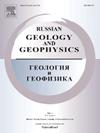The Kataevo Island Arc System of the Paleoasian Ocean (Transbaikalia): Composition, Age, Paleomagnetism, and Formation Geodynamic Settings
IF 1
4区 地球科学
Q3 GEOSCIENCES, MULTIDISCIPLINARY
引用次数: 0
Abstract
––Based on new data on the geology, composition, U–Pb isotopic age, and paleomagnetism of the metavolcanic rocks of the Kataevo Formation, we consider the geodynamic conditions of their formation and alteration. The Kataevo Formation metavolcanic rocks belong to the K–Na-high-alumina andesite–andesibasalt–basalt volcanic series. Results for U–Pb analysis of magmatic zircon (SHRIMP II, 8 spots) from a metaandesibasalt sample of the stratotype section on Ungo River yielded and age of 852 ± 9 Ma. Isotope systems for Sm–Nd yield a positive εNd(852) = +9.29, which indicates a juvenile magmatic source, close to depleted mantle (DM), with a Neoproterozoic protolith TNd(DM) model age. The content of the less mobile HFSE and REE (ppm) is consistently low for Nb (8–15), Ti (7074–12,410), Ta (0.32–0.93), Eu (1.80–2.29), Се (50–79), Y (21–25), Yb (2.1–2.8), Rb (10–24) and elevated for Sr (1000–1500), Zr (170–270), La (25–41), and Ba (600–800). All studied parameters place the metavolcanic rocks close to the contemporary Kurile–Kamchatka type of developed island arcs. Paleomagnetic analysis of the section of metavolcanic rocks shows a complete remagnetization ca. 120 Ma. This is synchronous with manifestations of intraplate basaltoid magmatism in the studied region, the most typical example of which is the Lower Cretaceous Khilok Formation.古亚洲洋(Transbaikalia)的Kataevo岛弧系统:组成、年龄、古地磁和地层地球动力学背景
–基于Kataevo组变质火山岩的地质、成分、U–Pb同位素年龄和古地磁的新数据,我们考虑了其形成和蚀变的地球动力学条件。Kataevo组变质火山岩属于K–Na高铝安山岩-安山岩-玄武岩火山系列。Ungo河层型段的变质安山岩样品的岩浆锆石(SHRIMP II,8个点)的U–Pb分析结果得出,年龄为852±9 Ma。Sm–Nd的同位素系统得出正εNd(852)=+9.29,这表明一个年轻的岩浆源,接近贫化地幔(DM),具有新元古代原岩TNd(DM)模型年龄。Nb(8–15)、Ti(7074–12410)、Ta(0.32–0.93)、Eu(1.80–2.29)、Се(50–79)、Y(21–25)、Yb(2.1–2.8)、Rb(10–24)的流动性较低,Sr(1000–1500)、Zr(170–270)、La(25–41)和Ba(600–800)的含量较高。所有研究的参数都将变火山岩置于现代Kurile-Kamchatka型发达岛弧附近。变质火山岩剖面的古地磁分析显示,约120 Ma发生了完全的再磁化。这与研究区域板内玄武质岩浆活动的表现同步,最典型的例子是下白垩纪Khilok组。
本文章由计算机程序翻译,如有差异,请以英文原文为准。
求助全文
约1分钟内获得全文
求助全文
来源期刊

Russian Geology and Geophysics
地学-地球科学综合
CiteScore
2.00
自引率
18.20%
发文量
95
审稿时长
4-8 weeks
期刊介绍:
The journal publishes original reports of theoretical and methodological nature in the fields of geology, geophysics, and geochemistry, which contain data on composition and structure of the Earth''s crust and mantle, describes processes of formation and general regularities of commercial mineral occurrences, investigations on development and application of geological-geophysical methods for their revealing. As to works of regional nature, accelerated publication are available for original papers on a variety of problems of comparative geology taking into account specific character of Siberia, adjacent Asian countries and water areas. The journal will also publish reviews, critical articles, chronicle of the most important scientific events, and advertisements.
 求助内容:
求助内容: 应助结果提醒方式:
应助结果提醒方式:


